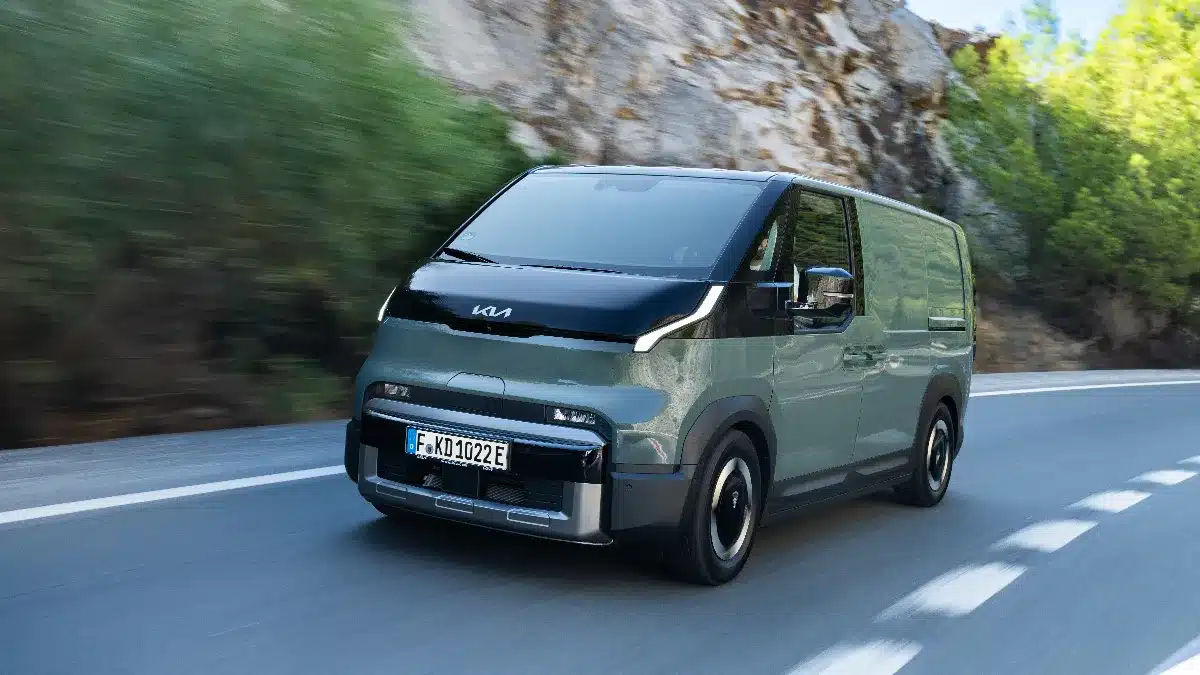
As debuts go, there are a few that stand out, Wayne Rooney at Everton, Lewis Hamilton racing for McLaren and now the Kia PV5 Cargo, as Kia's new electric van.
Comparing it to two titans of their sports is quite a comparison, but the new Kia PV5 electric van is a stunning debut, announcing Kia as an emerging force in the LCV segment.
The Kia electric van might be their first global light commercial vehicle, but it's not their first van. In fact, Kia made vans before they made cars and the arrival of the PV5 Cargo is arguably as important in South Korea as a replacement for the Ford Transit would be in the UK.
That's because the PV5 is the natural successor to the Kia Bongo one of the country’s most iconic vans. No pressure then.
After taking a very quick spin around a test track in a prototype van at the new Kia factory in South Korea, we’ve now driven the final full production model.
In January 2024, Kia revealed its ambitious plans to launch a range of electric vans.
It began with a display at CES in Las Vegas where a line-up of four new sizes of vans with multiple body types were unveiled. The range was called Kia PBV (Platform Beyond Vehicles) with a compact concept for a tiny autonomous city van (Kia PV1) joined by a much larger van (Kia PV7).
However, the new Kia van range starts with the PV5, a medium-sized van available as a panel van, chassis and as a passenger version, with more body types expected.
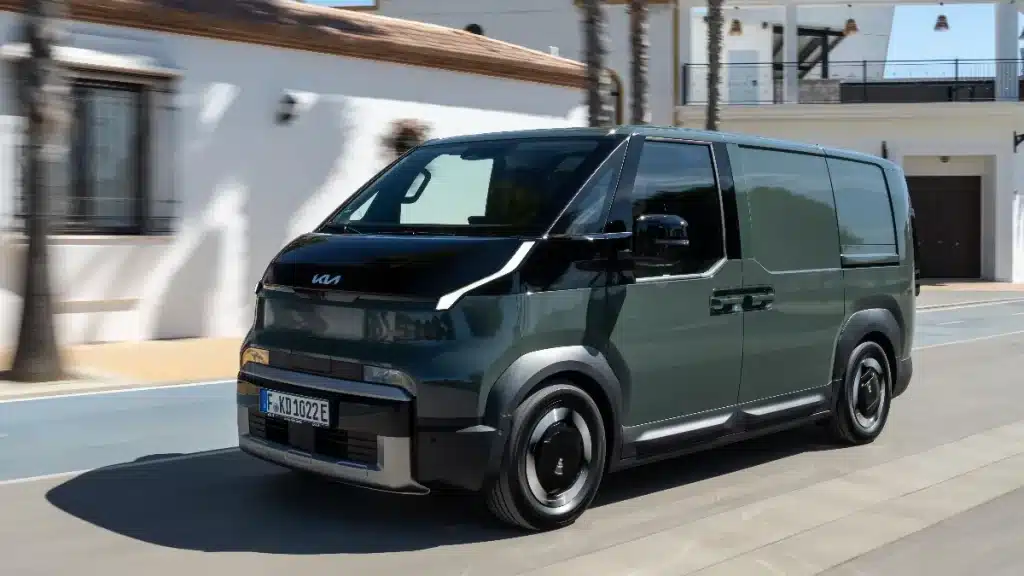
The electric Kia PV5 Cargo van is available in two different sizes and two heights. There’ll be a choice of two batteries with a claimed range of up to 258 miles for the largest battery.
Load volumes will range from 3.4m3 to 5.1m3, while the PV5 payload will be up to 770kg.
Vans will come with a choice of two trim levels, Essential and Plus.
Both Kia PV5 Cargo and the PV5 Passenger get a shared design, a futuristic look with vertical LED headlights and an unashamedly boxy profile.
It’s utilitarian, without being stark, with recessed looking, chunky door handles, and squared-off plastic trim around the wheel arches, along with additional protective trim running the length of the van.
On the inside there is a 7-inch instrument cluster and a 12.9-inch navigation screen in the centre. The PV5 uses an Android Automotive OS-based infotainment system, allow it to have regular over the air updates.
The PV5 Cargo Essential trim includes a host of kit as standard, in fact it’s one of the most comprehensive lists you’re likely to see. But in true panel van tradition it comes with a standard Solid White paint job.
There is a choice of five premium colours which include White Pearl, Midnight Black, Cityscape Green, Steel Grey and Mint Green. Optional paint colours cost £625 (+VAT) at launch.
Essential trim includes steel wheels, automatic LED headlights, electric mirrors and body coloured bumpers with black plastic moulding. It gets 16-inch steel wheels as standard, or there’s the option of an alloy wheel that looks part aerodynamic cover, part alloy.
Automatic rain sensing wipers, air conditioning, and a 12.9-inch touchscreen infotainment system are all included as standard, along with front and rear parking sensors and a reversing camera.

There’s surprisingly little in terms of features for the more costly Plus trim, which is an indication that there’s already quite a lot included as Standard on the Essential trim level van.
The most notable feature of the Plus trim PV5 is that it allows for charging of high-power devices from the load area. That means power tools or refrigeration units can be powered directly from the van.
There’s also heated front seats and a heated steering wheel. If you live in a cold country, or you’re particularly worried about range in the winter, there’s also the option of a heat pump on this trim which will set you back £640.
Plus trim includes:
Those are the basics of the van, it’s sizes and trim options. Although at launch there’s only the L2H1 model to begin with.
The long-wheelbase L2H1 version starts from £27,645 (excluding VAT and the Government Plug In Van Grant). The Plug In Van Grant reduces the price by the maximum amount, as despite being a small van, the PV5 Cargo has a GVW of 2,650kg, which puts it in the higher category. That means the PV5 gets the maximum £5000 discount.
Pricing has only been revealed for the larger wheelbase van, though. So the entry-level pricing will drop slightly from the £27,645 figure which is for the standard range 51.5kWh battery. The larger 71kWh battery will cost £2,500 with a starting price of £30,145.
The two trim levels, Essential and Plus, have a £1,100 price difference.
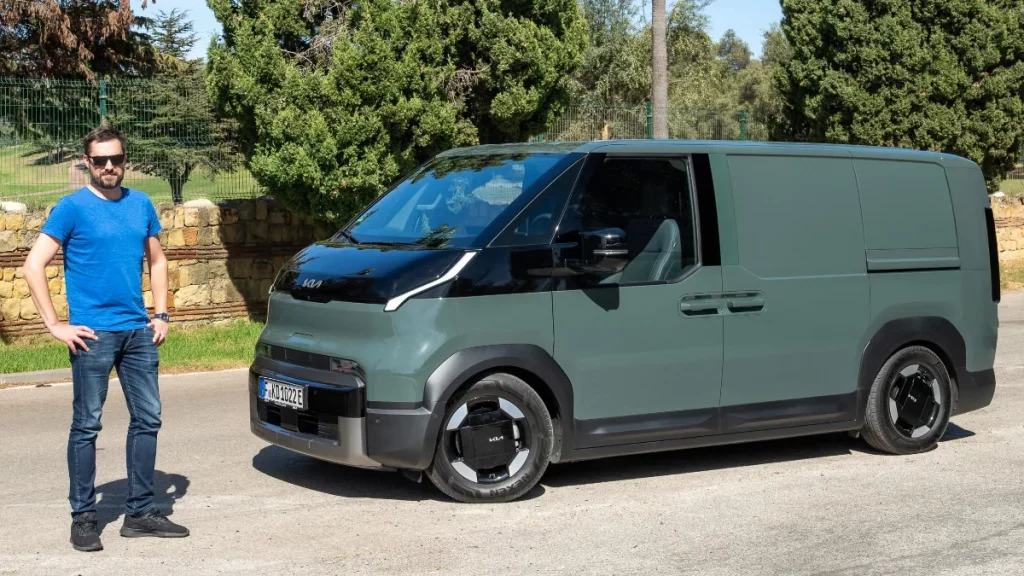
The Kia PV5 has been awarded a maximum 5-star rating in Euro NCAP's round of testing announced in December 2025.
The PV5 gained a 75% score for Safe Driving, an 80% score for Crash Avoidance and an 80% score for Post Crash Safety.
Although the range launches with the PV5 long-wheelbase (LWB) L2 version, there will be both smaller and taller models.
Overall the biggest PV5 you’ll find will measuring up to 4.7m long, while the standard height roof sees it just squeak under the 1.9m mark.
The 4.7m length makes it slightly smaller than a Ford Transit Custom but it's perhaps more of a natural rival to the Volkswagen ID Buzz Cargo. It’s shorter, narrower and not as high as the Buzz, but only by a handful of millimetres in all directions. Instead Kia seems to benchmark it against the Citroen e-Berlingo LWB, which the PV5 is comfortably bigger than.
Three body sizes will be eventually available with L1H1, L2H1 and L2H2 models. We’ve got more information on the full sizes of the range and the complete Kia PV5 dimensions in a separate article.
There’s also a separate guide to the Kia PV5 Passenger dimensions as well.
Load volumes for the Kia PV5 panel van range from 3.4m3 to 5.1m3. You get a nearside sliding rear door as standard, with barn style rear doors, but adding a second door will only cost you £355.
The motors and batteries in the PV5 range is built on an adapted version of the E-GMP platform which is currently used by the Kia EV6 and Kia EV9 electric passenger cars. However, the PV5 is most closely related to the Kia EV3, but there’s an important change to the platform.
Kia has developed a new ‘Service’ element to its universal skateboard, calling it E-GMP.S, which signifies that the PV5 Cargo and PV5 Passenger are based on a working vehicle.
That means there are a few changes to make it more affordable, the most notable of which is that the PV5 range will use a 400V electrical system, rather than 800V.
There’s no compromise on batteries though, with three batteries available at launch (although only the top two will come to the UK).
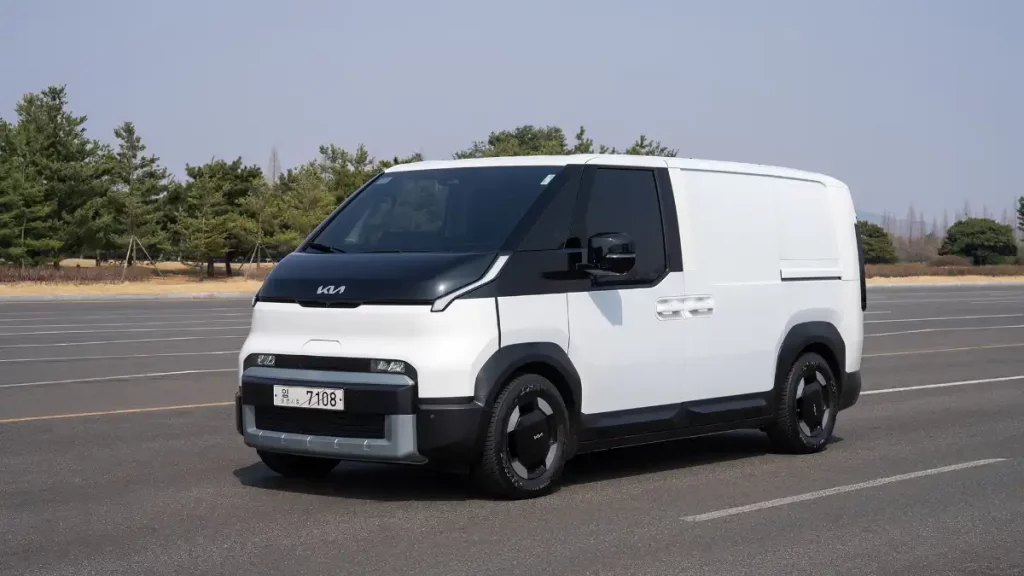
The range begins with a 43.3kWh (only available on PV5 Passenger, and not available at all in the UK), with a 51.5kWh option and range topping 71.2kWh battery.
The maximum range for the PV5, according to the WLTP test cycle, is 258 miles for the large 71.2kWh battery and 184 miles for the 51.5kWh battery.
These figures are both for the L2H1 version of the van.
Real world, we’ve managed figures far higher than both of these, which is where it gets really interesting.
Kia says the PV5 Cargo will only lose 1.5% of its range with every 100kg added. That means that even if fully laden they only expect the range to decrease by just over 10%. That’s quite a claim.

Official energy consumption figures for the PV5 Cargo are 19 kWh/100km, which is the equivalent of 3.27 miles per kilowatt-hour. However, during a very hilly test in Malaga where the route included motorways, a small amount of urban roads and a good amount of fast and flowing main roads we comfortably recorded 15 kWh/100km, the equivalent of 4.14mi/kWh.
The WLTP test also doesn’t include a payload, yet we tested the PV5 Cargo with a 400kg payload. That makes beating the claimed economy figure all the more impressive.
Furthermore, we’ve driven the van at full payload and seen even better results.
The claimed range of 258 miles for the big battery is then very much on the low end of the spectrum. In the real world, without even trying, we’d like to think that you’d easily achieve that figure even with weight on board.
As mentioned, Kia has given its new van customers plenty of options when it comes to the important issue of range. We’ll detail more on the batteries, range and charging for the Kia PV5 in another article, but you need to keep those battery numbers in mind when it comes to the power.
A front-wheel-drive electric motor, produces a maximum of 120kW and 250Nm of torque, however, that’s the power output for the biggest battery van.
The PV5 Cargo and Passenger with the 71.2kWh battery both have a power rating of 120kW, while the smaller 51.5kWh battery has a power output of 89.4kW. Both models get the same 250Nm torque output.

Now for the important bit, what the Kia PV5 is actually like to drive. As previously mentioned, we were been lucky enough to be the first British title to get behind the wheel of the prototype Kia PV5 Cargo.
That vehicle was an early pre-production model, and we were very limited as to how much and where we could drive it. Now though we’ve been behind the wheel for many hours and had the chance to dig deeper into our initial observations.
You won’t be blown away by the performance of the PV5, talking here about the PV5 Long Range, that’s the big battery model with the more powerful 120kW motor, it’s fast enough without feeling excessive. That’s probably a good thing, it’s about time we had some sense in the EV world, but it still raises doubts about the lower powered 89.4kW power output option. We’ll tell you more when we know.

What we can say about that powertrain and this one is that the 250Nm of torque is actually sufficient. There’s enough pull of the line with 400kg in the back to get the PV5 up to speed at a decent pace. It’s not a rocket ship, but it doesn’t need to be.
We can say that the 120kW motor is a sensible size for most applications and 250Nm of torque from an electric motor means that it’s punchy enough from the moment you floor the throttle. But it doesn’t feel like an excessive amount of power because the van feels bigger than it perhaps is.
Kia keeps mentioning that it’s actually a small van, comparing it to the likes of the Citroen e-Berlingo, when perhaps its height and width make it look more of a natural competitor to the Ford E-Transit Custom.
The 120kW motor puts its firmly in the middle of the E-Transit Custom’s power outputs and at the higher end of the small electric van segment. So it’s powerful, but only within the context of where it sits.
Glad you asked, because all electric vans seem to come with some sort of driving mode choices and the Kia PV5 van is no different.
There are three to choose from Normal, which is errr normal driving. Eco, which dulls down how fast you can accelerate, and Snow, which goes even further to manage how much power you put down so that you don't spin up the wheels.
The steering is light, heavily assisted and is a bit numb and disinterested. Like a sulky teenager, the PV5 doesn’t respond with the alertness you might expect of a dynamic electric vehicle, but as we’ve already mentioned, it isn’t one of those. In fact, without any fidgety steering, it matches the laid back vibe the PV5 gives off. This is a vehicle designed for work and if functional means boring, we’ll take grey and beige all day long, to get the job done.
When you do wind things up and pitch it into a curve, the van responds how you might expect, with a decent amount of understeer and a pretty rigid chassis that makes it pitch and roll into the bends. There’s not loads of body roll, so it’s not a bad thing, it’s just not geared up to be hustled in the same way that a Ford E-Transit Custom is.
An honourable mention must also go to the PV5’s turning circle, which for a short-wheelbase van, lives up to expectations. The PV5 turns like a black cab in a London street. The short nose, with almost no overhang, means you can see exactly where your front end will end up as well.

You won’t be at all surprised to hear that a van which isn’t designed to be fast, and doesn’t like an aggressive amount of cornering, is as soft and compliant as they come on the road.
If the benchmark for comfort is the the Mercedes-Benz eCitan (and its sibling the Renault Kangoo E-Tech) then the Kia PV5 is a couple of steps up on the ladder for its general state of calm.
Show the PV5 Cargo a bump and it’ll merrily glide over it, without too much of a crash or a bang. It’s easily the more relaxing van to drive in its class, if not the entire van industry. After hours of driving we barely noticed we’d been in it.
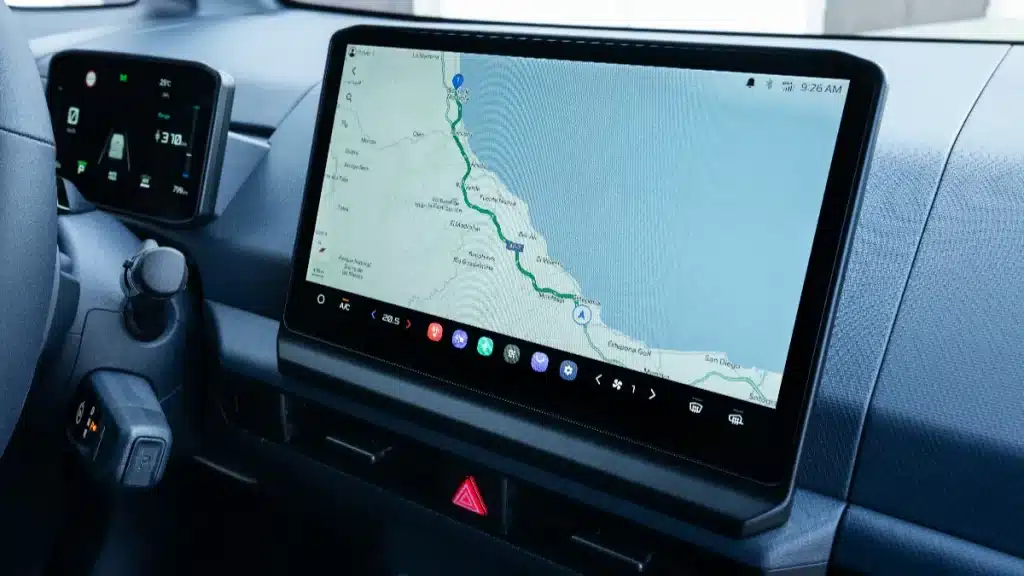
A lot of that is down to the driving position, which thanks to a fully adjustable steering wheel and a very forward seating position relative to the front axle not only makes it feel more dynamic than it actually is, but means that when you’ve got weight in the back there’s a really good balance across the whole of the van.
The seating position also makes the double A-pillar less of a problem than you might first think. Yes, you have to move forwards or sideways occasionally to look around the obstruction, but it’s far less intrusive than it looks in photographs.


There are some negatives, though. Because of that advanced seating position, the mirrors do feel very close to you, but overall visibility with them isn’t an issue. Again, they just block out a bit more of the road than you might expect.
Another gripe is that the arm rest isn’t adjustable. It’s either down or up. That might sound minor, but if you like a high seating position, it means that your arms will be at different levels, making you sit lopsided if you rest your outer arm on the door frame, which acts as a good support.
You can counteract this by lowering the seat, but it would be far better to have an arm rest that can stay in multiple positions.
The PV5 is a demonstration of how both research and restraint can make a brilliant product
- George Barrow, Van Reviewer
There’s also a need for a quick moan about cup holders. While the PV5 does have them, they’re at floor level in the centre console area. We’re not a fan for two reasons.
Firstly, that area hinders cross cab access, which while not really necessary in a small city van, is more important in a three-seat medium van. As the PV5 is closer to the latter than the former, we think they’re in the way.
Secondly, when it’s dark, you can’t see where your drink is. Cupholders need to be up high, so you can see them and you’re not looking down in the dark for things.
In the PV5’s defence, there is a solution for this, with an innovative rail system that lets you add your own bespoke accessories into the lines which you’ll find along the dash and even in the loadspace. It’s a nice idea, but so far we’ve only seen flimsy 3D-printed proof-of concept accessories, rather than anything more robust and long-term.




It most certainly does have regenerative braking with four differing levels. There’s also an automatic function too.
Alternatively there’s Auto mode which is the best of all worlds. It takes some getting used to, but it will use navigation information and information from cameras and safety systems to determine how severe the regen should be. It’s a bit jerky, and it can be overly enthusiastic to slow you down sometimes, but on the whole it’s a great system for maximising the amount of energy you get back, while also making use of the coasting function.

Cabin layout and its overall general feel are all very positive. The cockpit feels spacious, with ample room for knees and elbows, while also having the important functions like heating and infotainment close enough to hand.
The large central touchscreen works well, built on Android’s OS rather than anything thrown together by a car manufactuer, and you’ll find a huge amount of information in there, particularly for the electrical activity of the van. There are menus for energy consumption, both live and over time, there’s state of charge for the battery and also charging details.
It’s a very thorough system, which really shows you where Kia’s strengths lie in their whole portfolio of electric vehicles.
Storage is decent in the central area, where you've got two cupholders. There's also a decent sized glovebox and a large pull out draw in the base of the centre console.
Look to the side of that big draw, though, and you'll find a nifty little secret storage tray in the floor. Great for hiding your valuables, and a really smart addition to the van.
Another little moan has to be had about the lack of physicals buttons. It's not quite as bad as a Volkswagen Caddy, because Kia has been smart enough to put all the functions in little icons along the touchscreen, but when it comes to wanting to do something simple like changing temperature you've got to go in throuhg a touchscreen.
The overall appearance is certainly impressive and the materials used on the inside are of a high standard. and the quality exactly what you would expect from a brand willing to slap a seven-year warranty on something.
The Kia PV5 range is built in South Korea. To build the new models, Kia broke ground on a new production facility, for the entire PBV range, at their AutoLand Hwaseong Plant, southwest of the South Korea capital Seoul.
The PV5 will be the first van to be built there, alongside the Kia Tasman pick-up truck, with the ultimate aim of selling up to 250,000 vans by 2030 which will include the PV7 and a much larger Kia PV9.
The new manufacturing site has been designed solely to produce PBVs (platform beyond vehicles) and will use a bespoke and more flexible manufacturing process that will eventually see production reach up to 300,000 units.
Kia will give the PV5 Cargo a massive 7-year or 100,000-mile warranty as standard. That’s the same as Kia's passenger car range.
The dealer network will also start with 60 locations made up of existing Kia dealers as well as a few familiar names that already operate van franchises.
PV5 Cargo and PV5 Passenger will be available exclusively through this network of Kia van dealers.
Kia has also been upskilling its network, adding van specific learning to its apprenticeship programme at their Kia training college in Derby.
There's no doubting that this is a lot of van for the money. The PV5 is also a big van for a small van price. In fact, at just over £27.5k for the small battery and a shade over £30k for the large battery it's a bargain compared to any size of van.
If you're used to carrying around long lengths of wood or pipe, need to move full 8x4 sheet of ply or generally move a lot of large items you'll have to wait for the Kia PV7, but as a first entry into the van space the PV5 is an absolute winner.
Kia’s reputation for making some top-notch cars in recent years has really set the bar high for its PBV project.
Overall, the PV5 is an exceptionally well-balanced van and not just because of the weight distribution from the battery pack which is neatly nestled inside the van’s skateboard architecture.
The PV5 is a demonstration of how both research and restraint can make a brilliant product. It’s very clear that Kia set out to make the PV5 the best van in its class for all manner of key figures. By changing the shape, but by also being conservative in the performance and battery sizes, they’ve delivered a van that not only beats the competition on paper, but betters them in real life too.

To come back to the theme that we opened this review with, there’s one more impressive sporting debut we should mention.
Mike Tyson’s first round knockout of Hector Mercedes, more than 40 years ago on 6 March 1985, is still regarded as one of the sport’s greatest debuts, setting Tyson on the way to being known as the Baddest Man on the Planet. Could the PV5 be the start of an equally glittering career for the Kia PBV line-up? Are we looking at the Probably (the) Baddest Vans on the planet?